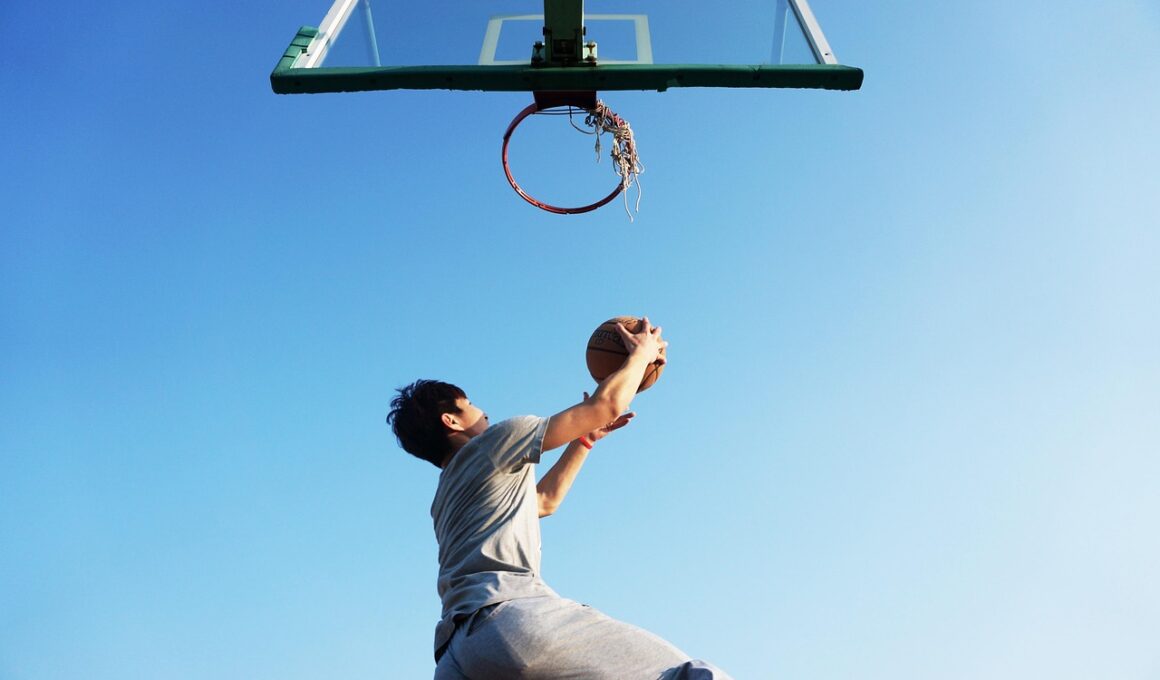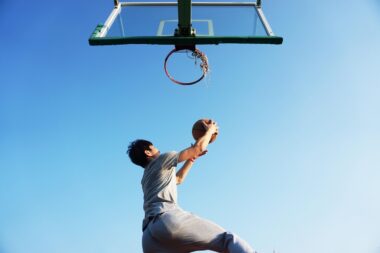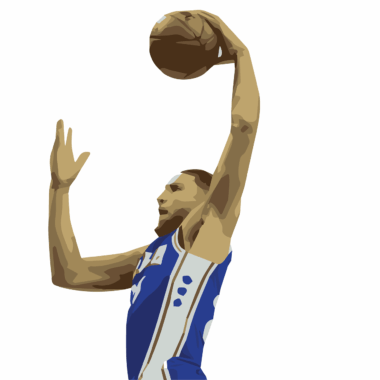How to Use Plyometric Training to Improve Basketball Dunking Ability
Plyometrics is a crucial training method, especially for basketball players aiming to enhance their dunking ability. Plyometric exercises help to develop explosive power, increase vertical leap, and improve overall athletic performance. By incorporating plyometric training into a regular workout routine, players can strengthen their muscles and enhance their coordination. Exercises such as box jumps, depth jumps, and plyometric push-ups focus on rapid stretch and contraction of muscles. In basketball, having explosive strength enables players to jump higher and react more quickly during games. Thus, plyometrics can significantly benefit players at every skill level. With consistent training, athletes can see improvements in their agility, strength, speed, and overall game performance. Additionally, these exercises can lead to more effective movements on the court, allowing them to maneuver around defenders. Players looking to dunk consistently need not only strength but also stamina and precise technique. Proper form in plyometric exercises is essential to prevent injury and maximize benefits, making it imperative for athletes to consult professionals when designing a training program. Incorporating plyometrics properly and systematically will ensure the best training outcomes.
One of the primary benefits of plyometrics is improved muscle elasticity which translates directly into better jumping capabilities. When the muscles are conditioned to react quickly and powerfully, athletes experience a boost in vertical leap height. This increased explosiveness is key for basketball players who want to perform powerful dunks. Additionally, plyometric training helps enhance muscular coordination. During a game, coordination is vital for executing complex plays, jumping, and rebounding. Exercises like tuck jumps and bounding work on muscle timing and synchronization, which are essential for effective court performance. Moreover, as athletes continue plyometric exercises, they also improve their cardiovascular fitness. Stronger hearts and lungs allow players to maintain higher energy levels throughout the game. This aspect also ensures better recovery during high-intensity intervals. To maximize the benefits, players should be mindful of their rest periods between plyometric exercises to facilitate muscle recovery. Balancing high-intensity workouts with proper recovery will prevent fatigue and overuse injuries. A well-structured plyometric routine can significantly impact a player’s dunking ability and overall performance, demonstrating the importance of including these exercises in athletic training.
Plyometric Exercises for Improved Dunking
To optimize dunking ability through plyometrics, certain exercises are particularly effective. Exercises like depth jumps, where players drop from a platform and explode upwards upon contact with the ground, directly target fast-twitch muscle fibers crucial for jumping higher. Box jumps also play a vital role; they can be performed at various heights to adapt to individual player training levels. These exercises not only train muscles for explosive power but also teach athletes how to cultivate proper landing techniques. Additionally, incorporating medicine ball slams into training routines can enhance upper body strength and core stability. A strong core is essential for maintaining balance while jumping and executing dunk attempts in a game. Always ensure to warm up prior to these plyometric sessions to prevent injuries. Flexibility exercises and lighter aerobic activities should precede heavier explosive workouts. Furthermore, focusing on proper technique during each exercise—such as aligning knees and engaging core muscles—enhances safety and effectiveness. In essence, developing a well-rounded routine combining various plyometric exercises will yield significant improvements in dunking ability for basketball players of all skill levels.
Implementing a structured plyometric training program requires careful planning and periodization. It is advisable that players start with low-volume, low-intensity exercises before progressing to more intense routines. This approach ensures the body adapts to the stress of plyometrics gradually, reducing the risk of injury. Initially, focusing on form and technique is crucial. Athletes should master basic movements before taking on more advanced exercises. Once comfortable, they can gradually increase the intensity and volume of their workouts. For instance, starting with basic jump squats before advancing to depth jumps is a sound strategy. Incorporating strength training alongside plyometrics can amplify results. Building foundational strength in the lower body will serve to enhance explosive power. Keep hydration and nutrition as a priority, fueling the body properly for workouts. Essential nutrients support recovery and improve performance. Likewise, athletes must not neglect rest days; adequate recovery is crucial to avoid overtraining. Listening to your body, staying attuned to its signals helps ensure meaningful progress without plateaus. Consistently re-evaluating your training plan allows adjustments that can lead to improved dunking capabilities over time.
Monitoring Progress in Plyometric Training
Tracking progress is an essential part of any training program, including plyometric workouts. Players should monitor their performance metrics, such as jump height or number of successful dunks, to measure effectiveness. Employing tools like vertical jump testers or simple measuring tapes will help quantify improvements. Regular assessments will inform athletes about the efficiency of their training strategies. Athletes may wish to log statistics such as the number of repetitions or sets completed during each session. This record can help identify patterns, successes, or areas needing improvement. Video analysis can also be beneficial, allowing players to examine their form during specific exercises. Regularly reviewing recordings helps pinpoint inefficiencies in movement. Setting measurable goals can significantly enhance motivation and accountability. For example, aiming for an increase in vertical leap over a set period creates a clear target for the athlete to strive toward. Establishing milestones within the training program makes progress tangible. Finally, celebrating small wins maintains morale and encourages perseverance, transforming the training process into a motivating journey towards improved dunking ability. By maintaining a focused approach to track their plyometric progress, players can achieve substantial results.
Incorporating plyometric training into the youth basketball player’s regimen should be approached with careful consideration. Teaching proper jumping and landing techniques early on can lay the foundation for future athletic success. It’s essential that training is tailored to the individual player’s development level and age. Younger athletes should focus on basic movements, gradually introducing more complex exercises as they grow. Educating young players about the benefits of plyometrics can also foster appreciation for physical training. Coaches should ensure that plyometric exercises are well-integrated with skill development sessions. Combining dribbling drills with plyometric work enhances this relationship between skills and physical training. For instance, performing a box jump followed by a layup reinforces both skill and strength simultaneously. Safety is paramount at this stage; ensuring proper warm-ups emphasize injury prevention can contribute to a positive training environment. Teaching young athletes the importance of balance, flexibility, and recovery reinforces healthy practices for life. Overall, introducing plyometrics to young basketball players enhances physical abilities while fostering fun and excitement around the sport, setting the stage for long-term dedication and success in their basketball journey.
Conclusion
Utilizing plyometric training effectively can dramatically improve a basketball player’s dunking ability and overall performance. From increasing explosive strength to enhancing cardiovascular fitness, the benefits are extensive. Players must combine resistance training with plyometric exercises to create a balanced training regimen. Start with foundational movements and gradually progress to more complex routines to maximize results while minimizing injury risks. Furthermore, monitoring performance and making strategic adjustments to training plans is crucial for continued progress. Lastly, ensuring that young players approach plyometrics safely and effectively can promote long-term athletic development. Coaches and players alike can recognize the critical role of plyometrics in achieving basketball ambitions. Consistency, discipline, and proper technique govern successful application. With moderate to advanced bounce workouts, players can redefine their playing style, conquering the height barrier that often limits dunking success. Thus, integrating plyometric training into regular basketball practice is non-negotiable for athletes seeking to unleash their full dunking potential. In conclusion, commit to structured plyometric training, cultivate an explosive style of play, and watch as dunking becomes a regular highlight in their basketball career.





